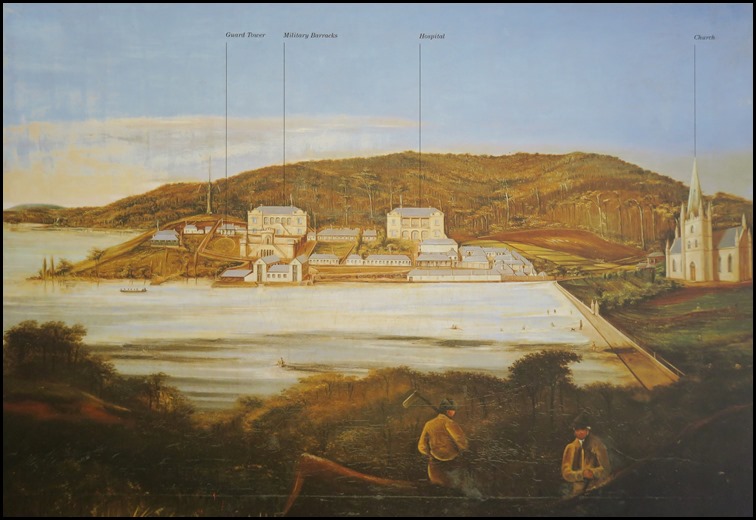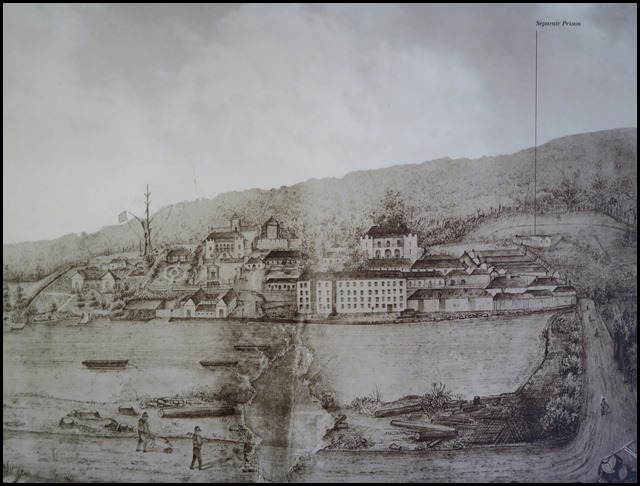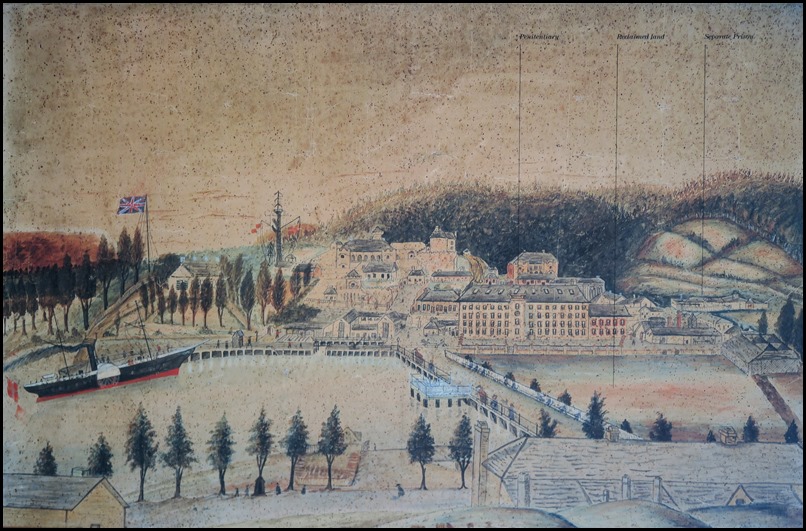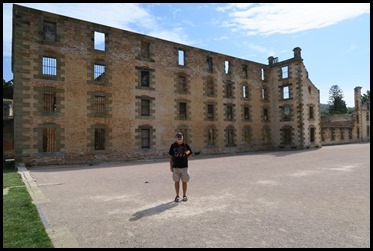Port Arthur

|
Port
Arthur
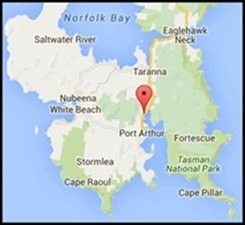  Our first morning as tourists of
Tasmania, we leapt up and headed for one of the top attraction on the island,
Port Arthur an hour and a half away. Mabel settled
into a smooth purr and we enjoyed the countryside as we went. As an introduction
to the site we have used the Port Arthur website which is a fantastic resource,
the information boards at the site and our pictures taken over our two day
visit.
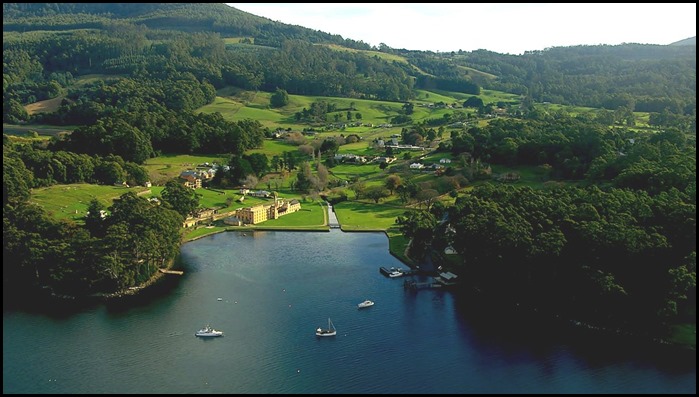 The stunning natural harbour of Port Arthur.
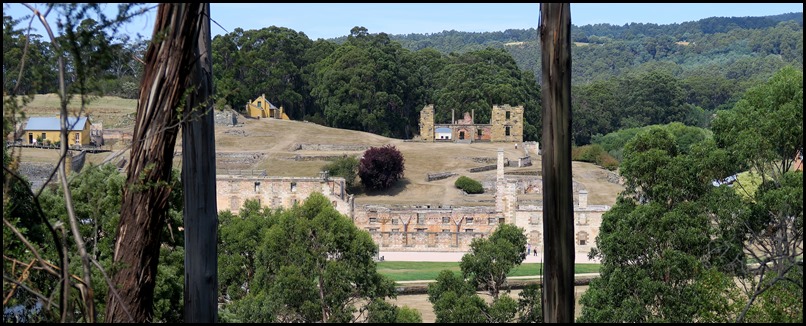 Our first look at
the site was walking down from the car park. The penitentiary in the
foreground and the hospital above. After we bought our two-day tickets we went
on the included guided walk and then returned to the main building to take
pictures of the timeline of Port Arthur, a fairly unique pictorial
history.
 1833. This
is the earliest image known of Port Arthur, made about three years after it was
founded and showing how small it was. At this stage it was in transition, from a
small timber-getting prison camp to a larger prison settlement. Inhabitants
included about thirty convicts and sixteen soldiers, under the supervision of a
Commandant. The small weatherboard buildings along the waterfront are all gone
now; they included prisoners’ and soldiers’ accommodation, stores and workshops.
Only the Commandant’s House still survives, although it has now had numerous
additions.
 Circa
1833. In this plan [other way up to the scene above] of the settlement by
J.H. Hughes, the earliest known, the new convict barracks shows that it was
beginning to expand from a small camp into an extensive prison. Gardens were
established early, and at this stage convicts were allowed to grow vegetables to
protect themselves from scurvy. Their allotments can be seen next to the
barracks.
 Late 1833.
A painting by C.H. Costantini, a convict artist who was at Port Arthur from
March to September 1833. The settlement had begun to expand in extent and now
included substantial buildings. The large building on the hill, shown far larger
than actual size, was built as cells at this time. A new store stood on the
shoreline.
Circa 1842. The small timber-getting settlement was growing into a prison for secondary offenders, transported men who had committed a crime elsewhere in the colonies and had to be punished again. Port Arthur now held about twelve hundred convicts and fewer than a hundred soldiers, and had grown to include a substantial Military Barracks and Hospital. The Guard Tower, that formed the formal front of the Barracks, and the facade of the Hospital still survive. A new and substantial Church demonstrated the central role of religion in the life of the settlement. Both still survive although much altered by fire and rebuilding.
1843. Artist unknown. The large water-powered Granary/Mill building was begun in 1842, so that the settlement could grind its own flour. During water shortages convicts in chains worked the treadmill.
Circa 1851. The Separate Prison, begun in 1847 but not complete in this image [artist unknown], can be seen on the hill. This building marked a change in the philosophy of reform and punishment, from physical punishment like flogging to solitary confinement and psychological intimidation.
Circa 1860. The Granary/Mill was converted to a Penitentiary to accommodate the notoriously dangerous convicts from the Norfolk Island settlement, which closed in 1852. Men were no longer locked up in large dormitories, but confined to separate cells. The Separate Prison was also extended, and it now included a wing for ‘the violently insane’. The other major change was the reclamation of the bay, which now formed a large, open space, with a broad path and jetty on the waterfront. This shows the settlement at its greatest extent, and is probably one of the images on which the model behind us was based.
The excellent and detailed model.
History of Port Arthur. Convict Life:
The Port Arthur penal settlement began life as a small
timber station in 1830. Originally designed as a replacement for the recently
closed timber camp at Birches Bay, Port Arthur quickly grew in importance within
the penal system of the colonies.
The initial decade of settlement saw a penal station hacked from the bush, and the first manufactories – such as ship building, shoemaking, smithing, timber and brick making – established. The 1840’s witnessed a consolidation of the industrial and penal nature of the settlement as the convict population reached over 1100. In 1842 a huge flour mill and granary (later the Penitentiary) was begun, as well as the construction of a hospital.
1848 saw the first stone laid for the Separate Prison [picture of model used], the completion of which brought about a shift in punishment philosophy from physical to mental subjugation. Port Arthur also expanded geographically as the convicts pushed further into the encircling hills to extract the valuable timber.
Who Were The Convicts?After the American War of Independence Britain could no longer send her convicts to America, so after 1788 they were transported to the Australian colonies. These men and women were convicted of crimes that seem trivial today, mostly stealing small articles or livestock, but they had been convicted at least once before and Britain’s policy was to treat such re-offenders harshly. The convicts sent to Van Diemen’s Land were most likely to be poor young people from rural areas or from the slums of big cities. One in five was a woman. Numbers of children were also transported with their parents. Few returned home.
Port Arthur – An Industrial Prison?Of all the laborious occupations some convicts were forced to carry out during their time at Port Arthur, timber-getting was to be the most punishing, yet also the most profitable. From the very early days of settlement gangs of convicts cut timber from the bush surrounding the settlement. The saws of the convicts supplied a steady stream of building materials to fulfil the needs of works both on and off the peninsula. The trees were enormous, much larger than the ones found today. When felled, a sawpit was dug under or near the log, so that it could be cut up into smaller lengths of wood. Two convicts used a pitsaw to cut the wood. One convict (the ‘Top Dog’) stood on top the log, whilst the other (the ‘Bottom Dog’) worked in the pit at the other end of the saw. His job was extremely uncomfortable, as his eyes and ears filled with sawdust. When the log was cut into a rough beam, a gang of up to fifty convicts, nicknamed the ‘centipede gang’, hefted the great weight upon their shoulders and carried the timber back to the main settlement. Here, in larger sawpits constructed near the water, the timber was cut up into the planks, beams, boards and spars needed for building. In 1841 the old Assignment system was replaced by that of Probation. This saw the Tasman Peninsula settled with five new stations, each of which had up to six hundred convicts working at agriculture or merely serving time. One probation station, Cascades, was settled with the primary focus of extracting timber from the north side of the peninsula. By 1846 Cascades had replaced Port Arthur as the main timber-producer on the peninsula. In 1850 the erection of a steam-powered sawmill and the laying of iron tramways increased production to such an extent that, by 1856, the area around Cascades had been completely stripped of useful timber. With the closure of Cascades, operations reverted back to Port Arthur. The sawmill and tramway rails were removed to Port Arthur and a great bank of covered sawpits built next to the Penitentiary. The tramways and log-slides (long log-lined channels which allowed timber to be slid down a hill) meant that the centipede gangs were no longer needed, enabling the convict gangs to cut timber further from the settlement. Sawpits were dotted throughout the hillsides surrounding Port Arthur, cutting the logs into smaller pieces of timber, which were then sent back to the main settlement by the tramway. At the settlement the timber was further cut up in the noisy sawmill and sawpits. The decade after 1856 was the busiest time for Port Arthur. However, the convicts were getting older and sicker. In the late 1860’s they could no longer work as well in the bush as they had once been able. As at Cascades, the area had also been stripped of all its useful timber. Up until the closure of Port Arthur in 1877, the old convicts were used to cut firewood, but no longer did they cut down the massive trees to feed the sawmill. From 1877 the area was given over to private interests, as individuals and companies began logging the area, often using the old convict tracks for transport. Today chainsaws have replaced the pitsaw, mechanical haulers the tram carts.
ALL IN ALL A MASSIVE SITE AND WE’VE ONLY JUST BEGUN STRANGE JUST TO BE A DERELICT PORT – I EXPECTED A SMALL TOWN ON THE SITE |
